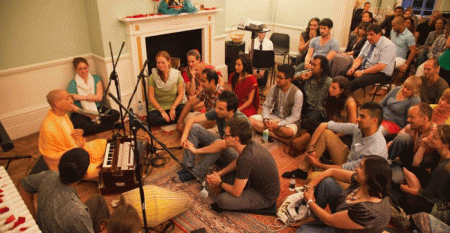In honor of Mother’s Day I decided to stretch myself and try something new. Â That something was Kirtan, which is basically singing meditation done in Hindi or Sanskrit in a call and response format.
I first heard of Kirtan from my friend Jennifer Alexander who leads Kirtan at Moksha Yoga in Chicago.
Since I’m just learning about it myself, I’m going to borrow a synopsis from Jennifer’s website that better describes what Kirtan is:
Kirtan is an ancient form of vibrational sound healing, which is practiced through the call and response chanting of mantras. A mantra is a sound, syllable, word, or group of words that is considered capable of creating energetic transformation. At a Kirtan concert, the band or song leader introduces the chant by singing the call, and the audience participates by singing back the response. The song and energy build through the call and response rhythm, transforming everyone in the room – whether you consider yourself a “singer”, are simply humming along, or are silently soaking in the vibration.
So there’s the definition of it. Â Here’s what my actual experience looked like:
The session was scheduled for 90 minutes at an Alternative Therapy Center. Â The center was situated in a house and our group formed a circle in the living room area. Â There were 9 people there that night (which is about average).
There were no introductions, which was odd to me. Â Everyone just simply found a floor cushion and quietly waited for the music to begin.
There was a man who led the calls who played the drums and the Harmonium (it is pictured above, kind of a combo between an accordion and a piano). Â There was also a guitarist that accompanied him. Â We had a sheet with the Hindi/Sanskrit phrases on it but there were no notes to be found.
As I mentioned before, this was a stretch for me comfort-wise and as often happens with discomfort, I spent the first 30 minutes in my head trying to decide if I liked it, if I fit with the people and if I was being meditative enough. Â Then my inner critic chimed in and told me that I wasn’t doing it right – wrong words, incorrect notes, not swaying properly, etc.
This inner battle went on for quite some time and then, as usually happens, I got swept up in the beauty of the music and stopped thinking. Â I can’t pinpoint exactly when that moment took place, but the energetic experience that followed for the next hour was one of deep calm and yet intense aliveness. Â It was a very cool paradox to linger in.
The crazy part was that we only did about 4 songs/chants. Â Each one lasted between 15-20 minutes and was composed of 2-4 lines (usually less than 15 words in all). Â I thought I’d get really bored by the repetition but the calls varied slightly each time in rhythm and intensity. Â Most songs/chants would start slow, grow to a build in both speed and volume and then slow down again to complete the chant.
Because the call varies each time, the only way to be able to repeat it back is to keep yourself in the present moment. Â There’s no time to think when you’re trying to repeat back words in Hindi and Sanskrit! Â The cool part was that as I stayed with the chant, it lulled me into this beautiful meditative place in which time evaporated. Â And let me tell you, time is not something that ever flies for me when I’m meditating. Â And yet it produced the same after-effects! Â How cool is that?
What I came to understand was that it wasn’t even about getting it right or sounding pretty.  It was simply about losing yourself (and your thinking mind) in the beauty and rhythm of the music.  I learned that people do it routinely as part of their meditative and yoga practices, which makes sense, since sound is yet another way to ground ourselves in the moment.
So there you have it folks. Â This new stretch activity is a keeper. Â Now to find a group I like in DC….who else is in?



Leave a reply